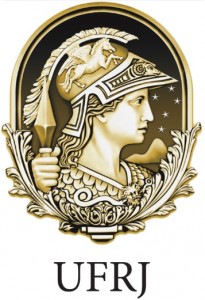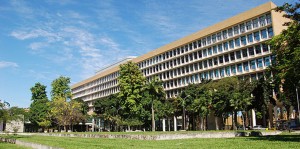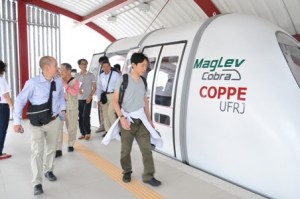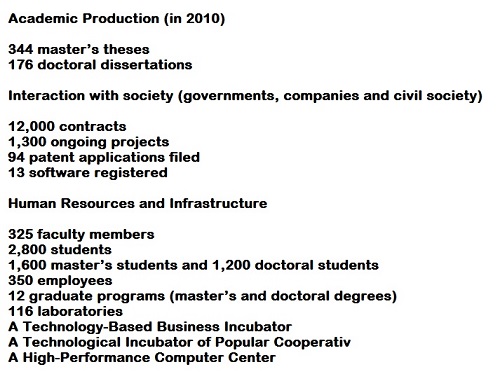Federal University of Rio de Janeiro (UFRJ), also known as University of Brazil, is the
largest federal university country and constitute one of the Brazilian centres of excellence in
teaching and research.
In terms of scientific, artistic and cultural is recognized nationally and internationally due to the performance of researchers and evaluations carried out by external agencies.
2014 QS World University Rankings put UFRJ as the best Brazilian federal university as well as the third best university in the country, fourth between the institutions of America Latina and the 60th best university of the BRICS and other in-development countries.
The Folha de S. Paulo’s University Ranking 2013 also ranked as the second best Brazilian university and as the best federal the country.
First official institution of higher education in Brazil, has 15 uninterrupted activity since 1792,
with the founding of the Royal Artillery Academy, fortification and Design, 16 of which
descends the current Polytechnic School.
As the first federal university created in the country in 1920 served as a model for others. In addition to the 157 undergraduate and 580 graduate, has seven museums, notably the National Museum, nine hospitals, hundreds of laboratories and 43 libraries. Its history and identity are interlaced with development course of development in Brazil in search of building a modern, competitive and socially fair country.
COPPE/UFRJ – The Alberto Luiz Coimbra Institute for Graduate Studies and Research in Engineering –helped renew Brazilian universities; thereby contributing to the country’s overall development. Founded in 1963 by the engineer Alberto Luiz Coimbra, the institution made it possible to create graduate courses in Brazil. Over the course of the last four decades it has become the most important centre for engineering research and education in Latin America.
The academic output reflects the standard of excellence. About 200 doctoral degrees and 300 master’s degrees are awarded annually. COPPE researchers publish about 2,000 scientific papers in national and international journals and conferences annually.
According to the last Capes evaluation (the Brazilian Federal Agency for Support and Evaluation of Graduate Courses), in September, 2010, COPPE was Brazil’s leading engineering graduate institute with the highest number of courses rated 7, which is equivalent to the performance of the most important and respected research and teaching centres in the world.
Academic Excellence
The academic output reflects the standard of excellence. About 200 doctoral degrees and 300 master’s degrees are awarded annually. Coppe researchers publish about 2,000 scientific papers in national and international journals and conferences annually. According to the last Capes evaluation (the Brazilian Federal Agency for Support and Evaluation of Graduate Courses), in September, 2010, Coppe was Brazil’s leading engineering graduate institute with the highest number of courses rated 7, which is equivalent to the performance of the most important and respected research and teaching centers in the world.
COPPE in Numbers:
Broadening its Horizons
Coppe has a staff and a research infrastructure that are permanently ready to meet the needs of Brazil’s economical, technological and social development. As Coppe is always looking to the future, the institution has served as a nation and worldwide model in engineering teaching and research and has helped Brazil face one of its most important challenges in its recent history.
COPPE has joint research projects with various internationally renowned scientific institutions. In addition, some of its faculty members are participating members of international committees, research institutions and multilateral bodies, such as the United Nations’ Intergovernmental Panel on Climate Change (IPPC), which was awarded the Nobel Peace Prize in 2007.
In 2008, COPPE expanded its role in the international t heater by creating the Brazil-China Center for Climate Change and Innovative Energy Technologies in partnership with Tsinghua University, which is the most prominent Chinese university in the field of engineering. The Center is headquartered at Beijing’s Tsinghua University, where an office is maintained for the coordination of activities and the establishment of contacts with Brazilian and Chinese companies that are potentially interested in technologies to be jointly developed.
Anticipating the Future for Four Decades
COPPE is characterized by its ability to remain one step ahead of the needs of Brazilian society. Aware of the importance of technology and science for the development of the country, Coppe has established the Coppetec Foundation in 1970, in order to manage its partnerships and projects. Coppetec Foundation has administered more than 12,000 contracts and partnerships with national and international, private and state-owned companies and governmental and non-governmental agencies. Presently, the Coppetec Foundation manages roughly 1,300 ongoing projects, as well as 94 patent applications and 13 software registered by COPPE .
COPPE and Petrobras, who have shared a partnership for more than 30 years, signed the first major cooperation agreement between the company and a university in 1977. By 1985, there were already 33 fixed platforms in operation in Brazil whose structural design was based on work carried out at COPPE.
The COPPE/Petrobras partnership has become a world reference model and has helped develop the technology that gives Brazil the leading position in deepwater oil exploration and production. The country has saved billions of dollars and has achieved self-sufficiency in oil.
As COPPEresearchers are capable of anticipating technological solutions and responding to future requests, they are already developing new technologies that will support Petrobras and the Brazilian government in the exploration and production of oil and gas in the pre-salt layers.





